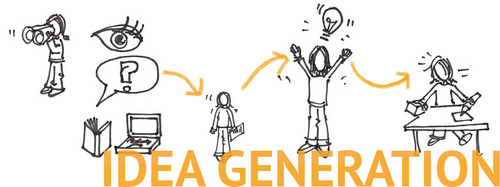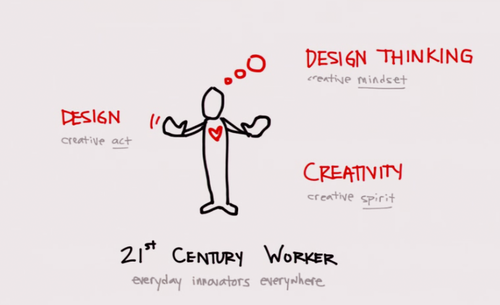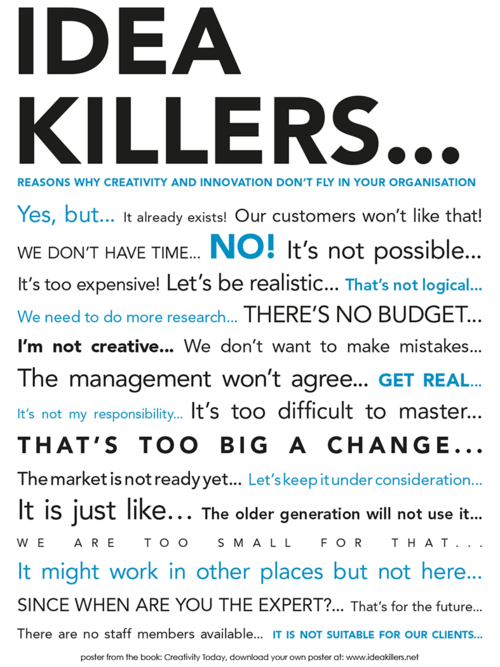Benefit N°seven: Creativity
I am aware, designers don't own creativity - everybody does, as David Kelley, founder of IDEO states in his book Creative Confidence:
"You may believe that architects and designers are paid to be creative thinkers, but CEOs, lawyers, and doctors are not. Or you may feel that being creative is a fixed trait, like having brown eyes - either you're born with creative genes, or you are not. We have come to see this set of misconceptions as "the creative myth". It is a myth that far too many people share. This book is about the opposite of that myth. It is about what we call "creative confidence". And at its foundation is the belief, that we are all creative."
source: Creative Confidence - unleashing the creative potential within us all, David Kelley, crown business, 2013
Now that we have given over our approach to problem solving and our design methods to everyone else, should we do the same with creativity? Is there still a need for Designers?
The good news: yes, of course, even more than ever!
But, let's talk a bit more about creativity first:
Creativity is a fluency that develops through practice, that needs techniques and above all a certain playful openness and mindset. It is the sort of mindset, following a passion that draws students to Design School versus Business school. It's a matter of looking at the world around you, of drawing inspiration from anything that crosses your way, of curiosity, of envisioning a picture of the future.
'If you do something, you're secure about, it can't be creative. Anything creative is totally insecure. Creativity is a consequence of work you do with your heart and your brain.'
source: Oliviero Toscani at the d.confestival, Potsdam 2012
Creativity can not be turned on and off. The process of finding new ideas is still not entirely decoded, but mainly consists of the following steps:

The initial phase in idea generation is preparation, scoping out the challenge, conducting primary research, structuring and observing. Followed by incubation, when you tend to feel lost and miserable, unable to find a solution to the problem. Get away from the problem, change your activity – and unconscious associations will happen more freely. So, by going through a 'defined' process with rigor and an open mind toward the end user, you will (eventually) succeed in finding an ideal solution, illumination and spontaneous thoughts may hit you. Followed by validation of the concept and execution.
As Thomas Edison stated: 'What innovation boils down to is 1% inspiration and 99% perspiration.'
Creativity is strongly connected to playfulness. Take a look at Tim Browns talk at the Ted serious play conference 2008. A secure and inspiring surrounding is key to give individuals freedom to play, to explore and take creative risks. (This is why offices of non-design firms have started to look more and more like design studios, hoping to trigger the employees' creativity). Brainstorming sessions produce better outcomes if you play by the rules (defer judgement and go for quantity), and ideas need to be translated into quick prototypes (a task that sometimes has a playground feeling to it) to get feedback and learn for the next iteration. A good way of prototyping a service is role play, to act it out.
It takes courage to be creative, to show precious ideas to others, to share them and to build on them together. It takes time. The advantage of being a designer is the mindset: we are courageous and willing to play.
Fortunately, the perception of design in the corporate world has changed to our advantage. Design is no longer looked at as 'styling and color', but as a strategic process to approach the challenges of our times with a broader perspective and multidisciplinary teams. We don't own methods or creativity, but we have broad experience and can use them to our advantage. And as we are entering existing systems as outsiders, we bring in a fresh perspective.
Taking a few seminars in Design Thinking wont turn anybody into a designer - just as taking a few business classes won't transform you into a business person. Although it may help to broaden our horizontal stroke and become more T-shaped and thereby valuable team players in the Innovation processes.
'Design agencies don't own creativity, but they do have the ability to take an idea and make it real. Showing the real value of naturally integrating strategy and design through creativity is the future, and those designers motivated to develop that skill are poised to succeed in it.'
source: Brian Gillespie in fastcodesign, March 1, 2013
- Erstellt am .

